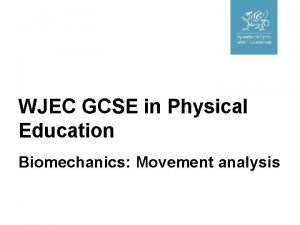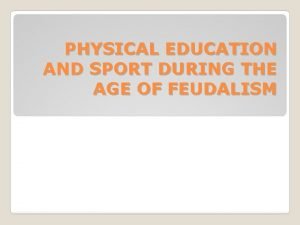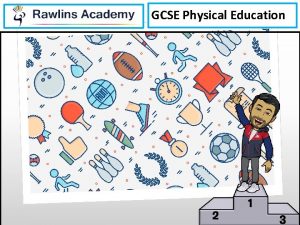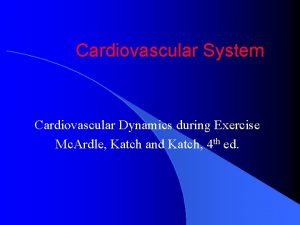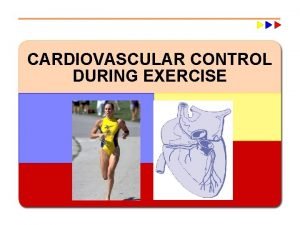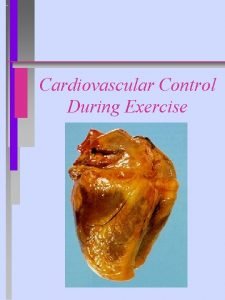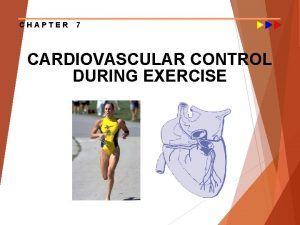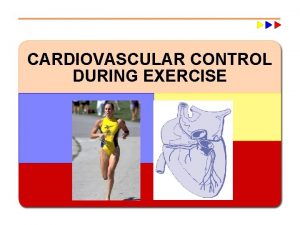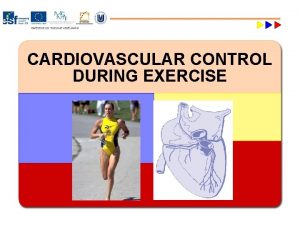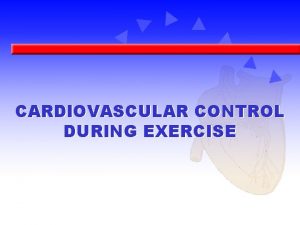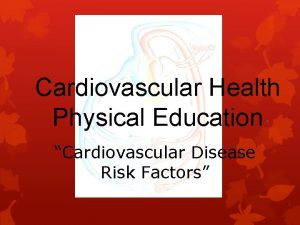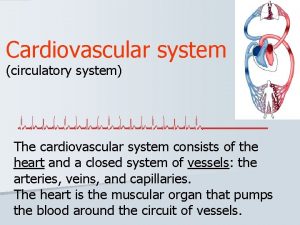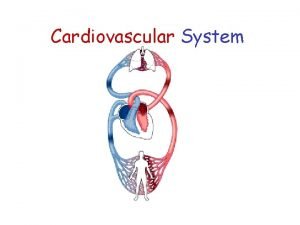GCSE Physical Education The Cardiovascular System During Exercise



















- Slides: 19

GCSE Physical Education The Cardiovascular System During Exercise

Learning Objectives By the end of this lesson pupils should: ü The immediate and short-term effects of participation in exercise and physical activity including: - Increased heart rate - Systolic/diastolic blood pressure - Increased blood pressure

The Cardiovascular System

The Cardiovascular System ü The cardiovascular system consists of the heart, blood and the blood vessels ü The heart is a muscular pump, which pushes blood throughout the many blood vessels in the body ü Blood being pushed around has 2 main functions: - to supply the body with oxygen & nutrients - to remove waste products e. g. carbon dioxide ü Blood vessels run throughout the body, allowing blood to travel everywhere

Effects During Exercise has a number of immediate effects on the cardiovascular system, what are they?

Increased Heart Rate

Increased Heart Rate ü Heart rate is the number of times the heart beats per minute ü Heart rate can vary considerably from person to person, however the normal resting heart rate is between 60 -80 beats per minute ü Exercise makes the body work harder. As a result, the muscles require more oxygen and more nutrients, such as glycogen, to function properly

Increased Heart Rate ü Oxygen and nutrients are carried to the muscles by the blood. The heart has to work faster to pump the blood around the body, therefore the heart rate increases ü To bring about a change in heart rate the body releases adrenaline, which is the main cause of changes in heart rate and blood pressure. Adrenaline is a hormone

Blood Pressure

Blood Pressure ü Blood pressure is the force exerted by circulating blood on the wall of the blood vessels. The heart makes two beating sounds ü Systole - made by the lower chambers contracting and pushing blood at high pressure into the arteries Diastole - made by the upper chambers contracting ü

Increased Blood Pressure ü Blood pressure is the force exerted by blood on the walls of the arteries ü Blood pressure increases during exercise because more blood is needed to be pumped around the body, increasing pressure on the blood vessels ü A blood pressure metre is used to measure systolic and diastolic blood pressure

Systolic & Diastolic Pressure

Systolic & Diastolic Pressure ü Systolic pressure - the maximum pressure in the arteries when the heart contracts (beats) and pushes blood out through the aorta into the body ü Diastolic pressure - the pressure of the blood during the relaxation phase between heart beats (when heart is at rest) ü Pulse pressure - the difference between systolic and diastolic pressures

Immediate Effects of Exercise

Immediate Effects of Exercise ü Breathing becomes deeper/faster - This is so more oxygen can be supplied to the lungs ü Body temperature increases - The working muscles generate heat causing the body’s temperature to rise. The body regulates temperature by heat radiating from the skin and through sweating ü Sweating starts & body requires fluids - Fluid is needed to cool the body down and to prevent dehydration ü Muscles begin to ache - Muscles need energy and oxygen to work. Glucose is used as the energy source, but lactic acid, a waste product, is also produced

Lactic Acid

Lactic Acid ü Lactic acid is a poison. It builds up slowly during exercise and during higher intensity work it builds up in muscles more quickly ü The reason for this build up could be poor training or a result of a depletion to the glycogen stores in the muscles as a result of a massive muscular effort ü After a while lactic acid will make muscles ache ü It will eventually cause cramp and stop muscles working. The athlete must rest while the blood brings fresh supplies of oxygen to the muscles

Learning Objectives (Revisited) By the end of this lesson pupils should: ü The immediate and short-term effects of participation in exercise and physical activity including: - Increased heart rate - Systolic/diastolic blood pressure - Increased blood pressure

Thank you Any questions, please do not hesitate to ask
 Movement analysis gcse pe
Movement analysis gcse pe Physical education during the age of feudalism
Physical education during the age of feudalism Ancient near east countries physical education
Ancient near east countries physical education Capillary bed
Capillary bed What makes up the cardiovascular system
What makes up the cardiovascular system Pithed rat model
Pithed rat model Cardiovascular/lymphatic system it's totally tubular
Cardiovascular/lymphatic system it's totally tubular Circulatory system crash course
Circulatory system crash course Medical terminology chapter 5 learning exercises answers
Medical terminology chapter 5 learning exercises answers Chapter 11 the cardiovascular system figure 11-3
Chapter 11 the cardiovascular system figure 11-3 Figure 11-2 is an anterior view of the heart
Figure 11-2 is an anterior view of the heart Chapter 11 the cardiovascular system
Chapter 11 the cardiovascular system Lesson 11 cardiovascular system
Lesson 11 cardiovascular system Tissues in the circulatory system
Tissues in the circulatory system Hypertensive atherosclerotic cardiovascular disease
Hypertensive atherosclerotic cardiovascular disease Introduction to cardiovascular system
Introduction to cardiovascular system Stent placement
Stent placement Anatomy and physiology unit 7 cardiovascular system
Anatomy and physiology unit 7 cardiovascular system Cardiovascular system diseases and disorders chapter 8
Cardiovascular system diseases and disorders chapter 8 Chapter 13 cardiovascular system
Chapter 13 cardiovascular system
